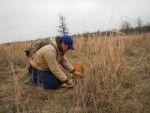A group of A&M researchers are working on a project that could help the Texas A&M Forest Service better predict fire dangers in different regions across the state.
Wayne Hamilton, senior lecturer in the ecosystem science and management department and a principal investigator at the Center for Natural Resource Information Technology, said the modeling system incorporates the simulation of the plant growth process into the model of fire danger in order to predict intensity of potential wildfires, to help better prepare for the fight against wildfires.
Fuel loading is the amount of combustible materials grass for instance per unit area on a weight basis. It is directly related to the intensity of the fire once it starts and therefore it is important to determine the risk of wildfires to the local area. Thomas Spencer, head of fire predictive services at Texas A&M Forest Service, said the group hopes this modeling system can give them a way to remotely sense fuel loading.
Spencer said to judge fuel loading in an area, the wildfire community can only send an specialist to judge for themselves. Therefore, the decision of whether the fuel loading is normal or not is based on experience and judgment.
“The reason it is important is that we really do not have a good scientific way to remotely sense herbaceous fuel loading,” Spencer said. “So if this model works, it will help streamline the process, reduce the subjectivity. Also if it works, then we are able to get that information out to the folks in the field, and help make our citizens safer, and our firefighters safer.”
Hamilton said the modeling system has two components. The first is the PHYGROW model, which simulates above-ground plant growth, forage consumption and hydrological processes. The other is a modified Risk Assessment Support System, which provides support to decisions related to prescribed burning and the risk of wildfire by utilizing near real-time weather conditions and fuel loads.
“The uniqueness about our model is the PHYGROW component,” Hamilton said. “Our model takes a count of multiple species associated with the range land, which we think does a good job of predicting [plant growth] given the soils, the weather and the grazing component.”
In order to use the PHYGROW model, the researchers first need to go to different counties to set up monitoring points and collect vegetation data, such as what type of plant and how much of that plant is in the area. Once the data is collected, researchers use it together with weather data from the National Weather Service and other data to run the simulation model.
“We are essentially growing the plants in our model,” said Jay Angerer, assistant professor at the Blacklands Research and Extension Center in Temple and member of the research team. “We also look at different conditions that may cause the plant to catch on fire.”
Another purpose of this research is to determine the resolution needed for sampling in order to provide accurate information on fire danger with the least amount of manpower and expense,
Hamilton said.
Right now, the researchers are collecting the field data in three North Texas counties: Stephens, Palo Pinto and Jack, all of which have the most frequent and damaging wildfires in Texas, Hamilton said.
A&M scientists aim to predict wildfires in Texas
August 13, 2013

Donate to The Battalion
Your donation will support the student journalists of Texas A&M University - College Station. Your contribution will allow us to purchase equipment and cover our annual website hosting costs.



















